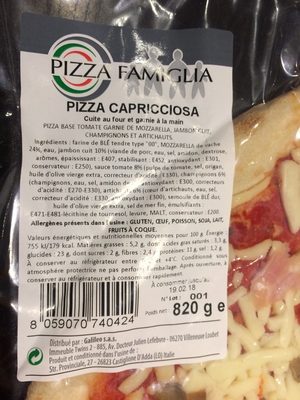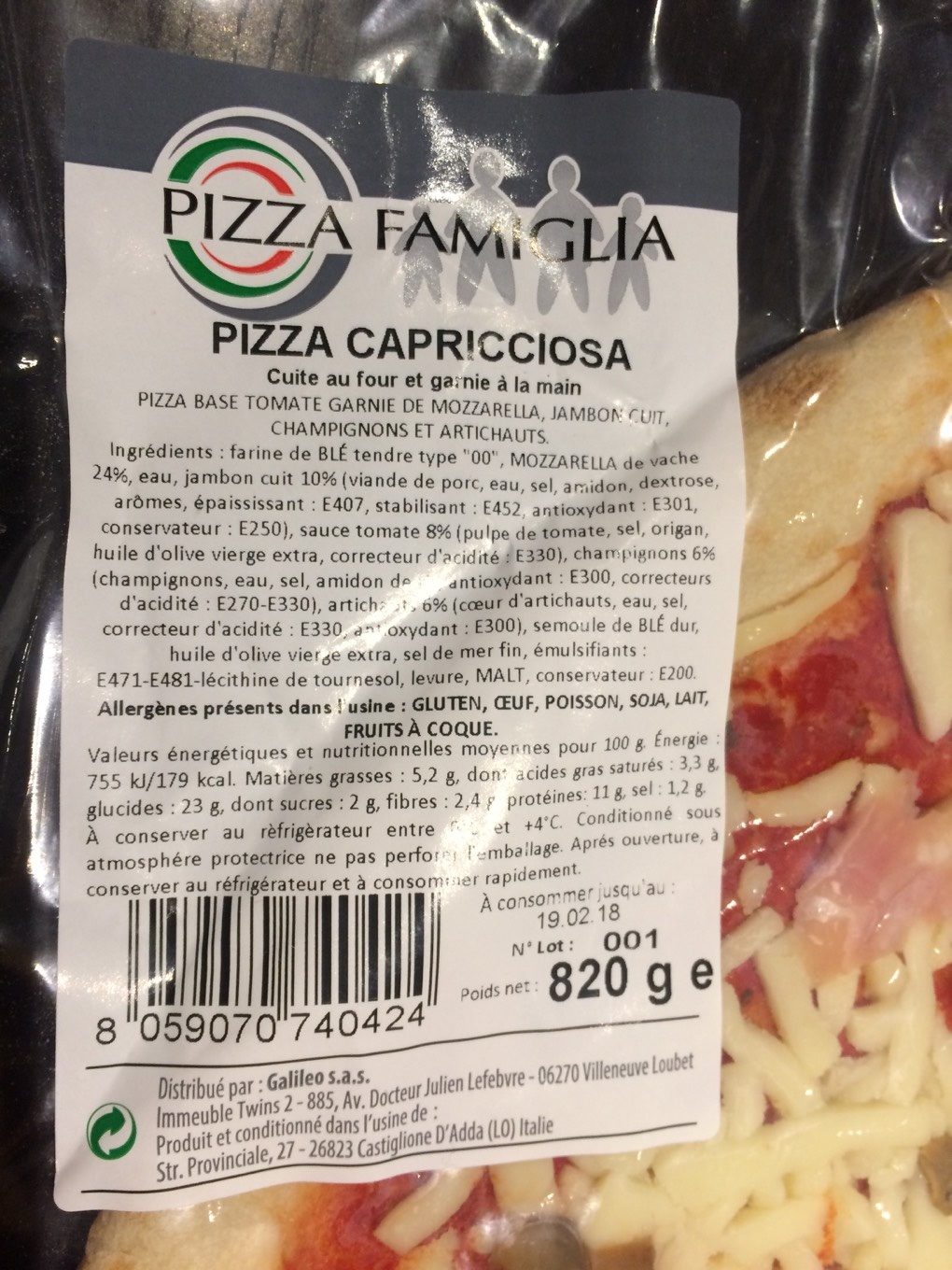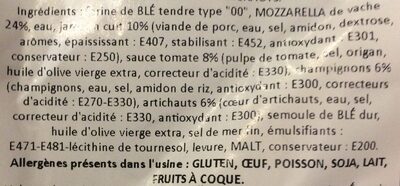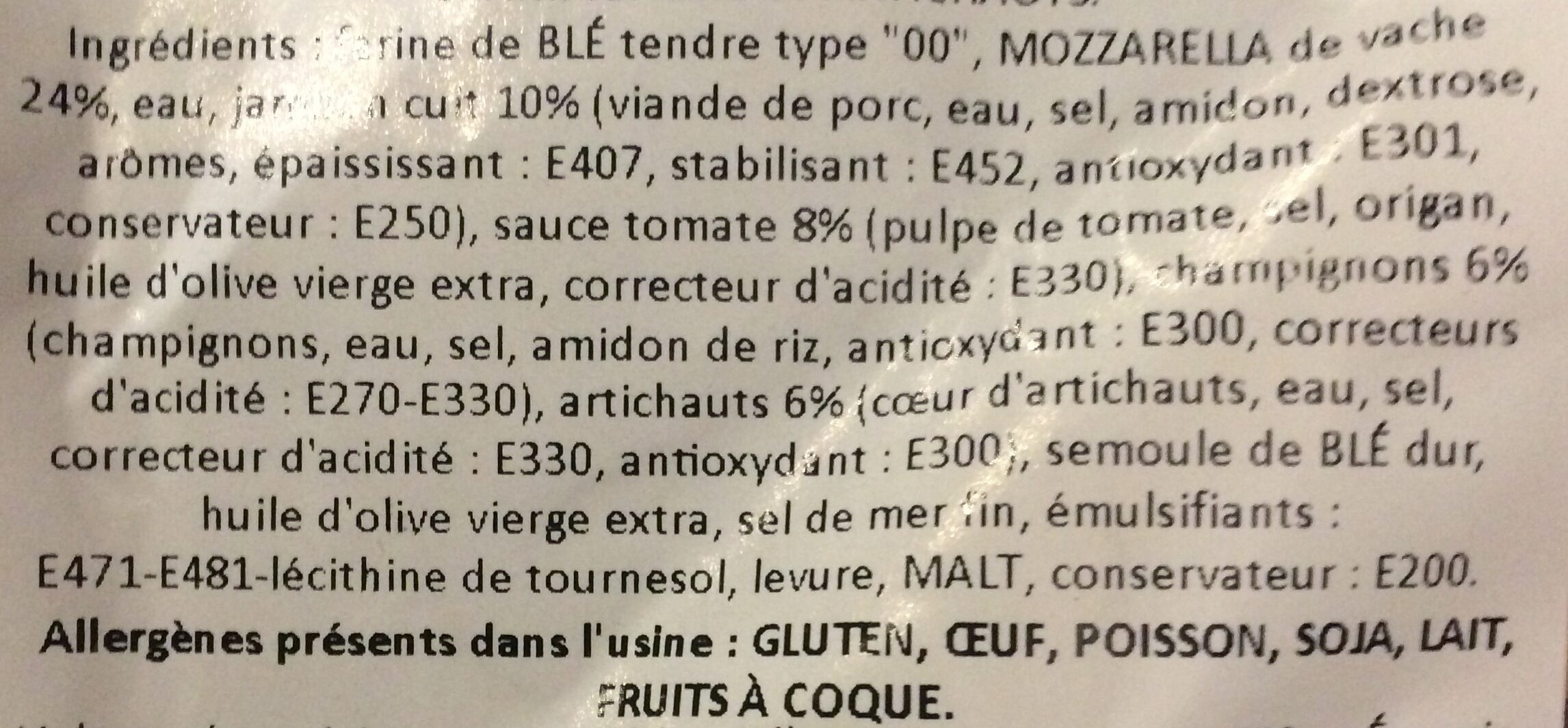Help us make food transparency the norm!
As a non-profit organization, we depend on your donations to continue informing consumers around the world about what they eat.
The food revolution starts with you!
Pizza capricciosa - Pizza Famiglia - 820 g
Pizza capricciosa - Pizza Famiglia - 820 g
This product page is not complete. You can help to complete it by editing it and adding more data from the photos we have, or by taking more photos using the app for Android or iPhone/iPad. Thank you!
×
Barcode: 8059070740424 (EAN / EAN-13)
Quantity: 820 g
Packaging: Vacuum-packed
Brands: Pizza Famiglia
Categories: Meals, Pizzas pies and quiches, Pizzas
Labels, certifications, awards:
Green Dot
Countries where sold: France
Matching with your preferences
Health
Ingredients
-
61 ingredients
: Farine de BLÉ tendre type "00", MOZZARELLA de vache 24%, eau, jambon cuit 10% (viande de porc, eau, sel, amidon, dextrose, arômes, épaississant : E407, stabilisant : E452, antioxydant E301, conservateur : E250), sauce tomate 8% (pulpe de tomate, sel, origan, huile d'olive vierge extra, correcteur d'acidité : E330), champignons 6% (champignons, eau, sel, amidon de riz, antioxydant : E300, correcteurs d'acidité : E270-E330), artichauts 6% (coeur d'artichauts, eau, sel, correcteur d'acidité : E330, antioxydant : E300), semoule de BLÉ dur, huile d'olive vierge extra, sel de mer fin, émulsifiants: E471, E481, lécithine de tournesol; levure, MALT, conservateur : E200. Allergènes présents dans l'usine : GLUTEN, OEUF, POISSON, SOJA, LAIT, FRUITS À COQUE.Allergens: Eggs, Fish, Gluten, Milk, Nuts, Soybeans
Food processing
-
Ultra processed foods
Elements that indicate the product is in the 4 - Ultra processed food and drink products group:
- Additive: E322 - Lecithins
- Additive: E407 - Carrageenan
- Additive: E452 - Polyphosphates
- Additive: E471 - Mono- and diglycerides of fatty acids
- Additive: E481 - Sodium stearoyl-2-lactylate
- Ingredient: Dextrose
- Ingredient: Emulsifier
- Ingredient: Flavouring
- Ingredient: Glucose
- Ingredient: Gluten
- Ingredient: Thickener
Food products are classified into 4 groups according to their degree of processing:
- Unprocessed or minimally processed foods
- Processed culinary ingredients
- Processed foods
- Ultra processed foods
The determination of the group is based on the category of the product and on the ingredients it contains.
Additives
-
E200 - Sorbic acid
Sorbic acid: Sorbic acid, or 2‚4-hexadienoic acid, is a natural organic compound used as a food preservative. It has the chemical formula CH3-CH-4CO2H. It is a colourless solid that is slightly soluble in water and sublimes readily. It was first isolated from the unripe berries of the Sorbus aucuparia -rowan tree-, hence its name.Source: Wikipedia
-
E250 - Sodium nitrite
Sodium nitrite: Sodium nitrite is the inorganic compound with the chemical formula NaNO2. It is a white to slightly yellowish crystalline powder that is very soluble in water and is hygroscopic. It is a useful precursor to a variety of organic compounds, such as pharmaceuticals, dyes, and pesticides, but it is probably best known as a food additive to prevent botulism. It is on the World Health Organization's List of Essential Medicines, the most important medications needed in a basic health system.Nitrate or nitrite -ingested- under conditions that result in endogenous nitrosation has been classified as "probably carcinogenic to humans" by International Agency for Research on Cancer -IARC-.Source: Wikipedia
-
E270 - Lactic acid
Lactic acid: Lactic acid is an organic compound with the formula CH3CH-OH-COOH. In its solid state, it is white and water-soluble. In its liquid state, it is colorless. It is produced both naturally and synthetically. With a hydroxyl group adjacent to the carboxyl group, lactic acid is classified as an alpha-hydroxy acid -AHA-. In the form of its conjugate base called lactate, it plays a role in several biochemical processes. In solution, it can ionize a proton from the carboxyl group, producing the lactate ion CH3CH-OH-CO−2. Compared to acetic acid, its pKa is 1 unit less, meaning lactic acid deprotonates ten times more easily than acetic acid does. This higher acidity is the consequence of the intramolecular hydrogen bonding between the α-hydroxyl and the carboxylate group. Lactic acid is chiral, consisting of two optical isomers. One is known as L--+--lactic acid or -S--lactic acid and the other, its mirror image, is D--−--lactic acid or -R--lactic acid. A mixture of the two in equal amounts is called DL-lactic acid, or racemic lactic acid. Lactic acid is hygroscopic. DL-lactic acid is miscible with water and with ethanol above its melting point which is around 17 or 18 °C. D-lactic acid and L-lactic acid have a higher melting point. In animals, L-lactate is constantly produced from pyruvate via the enzyme lactate dehydrogenase -LDH- in a process of fermentation during normal metabolism and exercise. It does not increase in concentration until the rate of lactate production exceeds the rate of lactate removal, which is governed by a number of factors, including monocarboxylate transporters, concentration and isoform of LDH, and oxidative capacity of tissues. The concentration of blood lactate is usually 1–2 mM at rest, but can rise to over 20 mM during intense exertion and as high as 25 mM afterward. In addition to other biological roles, L-lactic acid is the primary endogenous agonist of hydroxycarboxylic acid receptor 1 -HCA1-, which is a Gi/o-coupled G protein-coupled receptor -GPCR-.In industry, lactic acid fermentation is performed by lactic acid bacteria, which convert simple carbohydrates such as glucose, sucrose, or galactose to lactic acid. These bacteria can also grow in the mouth; the acid they produce is responsible for the tooth decay known as caries. In medicine, lactate is one of the main components of lactated Ringer's solution and Hartmann's solution. These intravenous fluids consist of sodium and potassium cations along with lactate and chloride anions in solution with distilled water, generally in concentrations isotonic with human blood. It is most commonly used for fluid resuscitation after blood loss due to trauma, surgery, or burns.Source: Wikipedia
-
E301 - Sodium ascorbate
Sodium ascorbate: Sodium ascorbate is one of a number of mineral salts of ascorbic acid -vitamin C-. The molecular formula of this chemical compound is C6H7NaO6. As the sodium salt of ascorbic acid, it is known as a mineral ascorbate. It has not been demonstrated to be more bioavailable than any other form of vitamin C supplement.Sodium ascorbate normally provides 131 mg of sodium per 1‚000 mg of ascorbic acid -1‚000 mg of sodium ascorbate contains 889 mg of ascorbic acid and 111 mg of sodium-. As a food additive, it has the E number E301 and is used as an antioxidant and an acidity regulator. It is approved for use as a food additive in the EU, USA, and Australia and New Zealand.In in vitro studies, sodium ascorbate has been found to produce cytotoxic effects in various malignant cell lines, which include melanoma cells that are particularly susceptible.Source: Wikipedia
-
E322 - Lecithins
Lecithins are natural compounds commonly used in the food industry as emulsifiers and stabilizers.
Extracted from sources like soybeans and eggs, lecithins consist of phospholipids that enhance the mixing of oil and water, ensuring smooth textures in various products like chocolates, dressings, and baked goods.
They do not present any known health risks.
-
E322i - Lecithin
Lecithins are natural compounds commonly used in the food industry as emulsifiers and stabilizers.
Extracted from sources like soybeans and eggs, lecithins consist of phospholipids that enhance the mixing of oil and water, ensuring smooth textures in various products like chocolates, dressings, and baked goods.
They do not present any known health risks.
-
E330 - Citric acid
Citric acid is a natural organic acid found in citrus fruits such as lemons, oranges, and limes.
It is widely used in the food industry as a flavor enhancer, acidulant, and preservative due to its tart and refreshing taste.
Citric acid is safe for consumption when used in moderation and is considered a generally recognized as safe (GRAS) food additive by regulatory agencies worldwide.
-
E407 - Carrageenan
Carrageenan (E407), derived from red seaweed, is widely employed in the food industry as a gelling, thickening, and stabilizing agent, notably in dairy and meat products.
It can exist in various forms, each imparting distinct textural properties to food.
However, its degraded form, often referred to as poligeenan, has raised health concerns due to its potential inflammatory effects and its classification as a possible human carcinogen (Group 2B) by the International Agency for Research on Cancer (IARC).
Nevertheless, food-grade carrageenan has been deemed safe by various regulatory bodies when consumed in amounts typically found in food.
-
E471 - Mono- and diglycerides of fatty acids
Mono- and diglycerides of fatty acids (E471), are food additives commonly used as emulsifiers in various processed foods.
These compounds consist of glycerol molecules linked to one or two fatty acid chains, which help stabilize and blend water and oil-based ingredients. E471 enhances the texture and shelf life of products like margarine, baked goods, and ice cream, ensuring a smooth and consistent texture.
It is generally considered safe for consumption within established regulatory limits.
-
E481 - Sodium stearoyl-2-lactylate
Sodium stearoyl lactylate: Sodium stearoyl-2-lactylate -sodium stearoyl lactylate or SSL- is a versatile, FDA approved food additive used to improve the mix tolerance and volume of processed foods. It is one type of a commercially available lactylate. SSL is non-toxic, biodegradable, and typically manufactured using biorenewable feedstocks. Because SSL is a safe and highly effective food additive, it is used in a wide variety of products ranging from baked goods and desserts to pet foods.As described by the Food Chemicals Codex 7th edition, SSL is a cream-colored powder or brittle solid. SSL is currently manufactured by the esterification of stearic acid with lactic acid and partially neutralized with either food-grade soda ash -sodium carbonate- or caustic soda -concentrated sodium hydroxide-. Commercial grade SSL is a mixture of sodium salts of stearoyl lactylic acids and minor proportions of other sodium salts of related acids. The HLB for SSL is 10-12. SSL is slightly hygroscopic, soluble in ethanol and in hot oil or fat, and dispersible in warm water. These properties are the reason that SSL is an excellent emulsifier for fat-in-water emulsions and can also function as a humectant.Source: Wikipedia
Ingredients analysis
-
May contain palm oil
Ingredients that may contain palm oil: E471, E481
-
Non-vegan
Non-vegan ingredients: Cow mozzarella, Cooked ham, Pork meat, Egg, Fish, MilkSome ingredients could not be recognized.
We need your help!
You can help us recognize more ingredients and better analyze the list of ingredients for this product and others:
- Edit this product page to correct spelling mistakes in the ingredients list, and/or to remove ingredients in other languages and sentences that are not related to the ingredients.
- Add new entries, synonyms or translations to our multilingual lists of ingredients, ingredient processing methods, and labels.
If you would like to help, join the #ingredients channel on our Slack discussion space and/or learn about ingredients analysis on our wiki. Thank you!
-
Non-vegetarian
Non-vegetarian ingredients: Cooked ham, Pork meat, FishSome ingredients could not be recognized.
We need your help!
You can help us recognize more ingredients and better analyze the list of ingredients for this product and others:
- Edit this product page to correct spelling mistakes in the ingredients list, and/or to remove ingredients in other languages and sentences that are not related to the ingredients.
- Add new entries, synonyms or translations to our multilingual lists of ingredients, ingredient processing methods, and labels.
If you would like to help, join the #ingredients channel on our Slack discussion space and/or learn about ingredients analysis on our wiki. Thank you!
-
Details of the analysis of the ingredients
We need your help!
Some ingredients could not be recognized.
We need your help!
You can help us recognize more ingredients and better analyze the list of ingredients for this product and others:
- Edit this product page to correct spelling mistakes in the ingredients list, and/or to remove ingredients in other languages and sentences that are not related to the ingredients.
- Add new entries, synonyms or translations to our multilingual lists of ingredients, ingredient processing methods, and labels.
If you would like to help, join the #ingredients channel on our Slack discussion space and/or learn about ingredients analysis on our wiki. Thank you!
: Farine de BLÉ tendre type "00", MOZZARELLA de vache 24%, eau, jambon cuit 10% (viande de porc, eau, sel, amidon, dextrose, arômes, épaississant (e407), stabilisant (e452), antioxydant (e301), conservateur (e250)), sauce tomate 8% (pulpe de tomate, sel, origan, huile d'olive vierge extra, correcteur d'acidité (e330)), champignons 6% (champignons, eau, sel, amidon de riz, antioxydant (e300), correcteurs d'acidité (e270), e330), artichauts 6% (coeur d'artichauts, eau, sel, correcteur d'acidité (e330), antioxydant (e300)), semoule de BLÉ dur, huile d'olive vierge extra, sel de mer fin, émulsifiants (e471), e481, lécithine de tournesol, levure, MALT, conservateur (e200, Allergènes présents dans l'usine), GLUTEN, OEUF, POISSON, SOJA, LAIT, FRUITS À COQUE- Farine de BLÉ tendre type "00" -> en:wheat-flour-type-00 - vegan: yes - vegetarian: yes - ciqual_proxy_food_code: 9410 - percent_min: 24 - percent_max: 36
- MOZZARELLA de vache -> en:cow-mozzarella - vegan: no - vegetarian: maybe - ciqual_food_code: 19590 - percent_min: 24 - percent: 24 - percent_max: 24
- eau -> en:water - vegan: yes - vegetarian: yes - ciqual_food_code: 18066 - percent_min: 10 - percent_max: 22
- jambon cuit -> en:cooked-ham - vegan: no - vegetarian: no - ciqual_proxy_food_code: 28205 - percent_min: 10 - percent: 10 - percent_max: 10
- viande de porc -> en:pork-meat - vegan: no - vegetarian: no - ciqual_proxy_food_code: 28205 - percent_min: 1 - percent_max: 10
- eau -> en:water - vegan: yes - vegetarian: yes - ciqual_food_code: 18066 - percent_min: 0 - percent_max: 5
- sel -> en:salt - vegan: yes - vegetarian: yes - ciqual_food_code: 11058 - percent_min: 0 - percent_max: 1.2
- amidon -> en:starch - vegan: yes - vegetarian: yes - ciqual_proxy_food_code: 9510 - percent_min: 0 - percent_max: 1.2
- dextrose -> en:dextrose - vegan: yes - vegetarian: yes - ciqual_proxy_food_code: 31016 - percent_min: 0 - percent_max: 1.2
- arômes -> en:flavouring - vegan: maybe - vegetarian: maybe - percent_min: 0 - percent_max: 1.2
- épaississant -> en:thickener - percent_min: 0 - percent_max: 1.2
- e407 -> en:e407 - vegan: yes - vegetarian: yes - percent_min: 0 - percent_max: 1.2
- stabilisant -> en:stabiliser - percent_min: 0 - percent_max: 1.2
- e452 -> en:e452 - vegan: yes - vegetarian: yes - percent_min: 0 - percent_max: 1.2
- antioxydant -> en:antioxidant - percent_min: 0 - percent_max: 1.2
- e301 -> en:e301 - vegan: yes - vegetarian: yes - percent_min: 0 - percent_max: 1.2
- conservateur -> en:preservative - percent_min: 0 - percent_max: 1
- e250 -> en:e250 - vegan: yes - vegetarian: yes - percent_min: 0 - percent_max: 1
- sauce tomate -> en:tomato-sauce - vegan: maybe - vegetarian: maybe - ciqual_proxy_food_code: 11107 - percent_min: 8 - percent: 8 - percent_max: 8
- pulpe de tomate -> en:tomato-pulp - vegan: yes - vegetarian: yes - ciqual_food_code: 20169 - percent_min: 3.2 - percent_max: 8
- sel -> en:salt - vegan: yes - vegetarian: yes - ciqual_food_code: 11058 - percent_min: 0 - percent_max: 1.2
- origan -> en:oregano - vegan: yes - vegetarian: yes - ciqual_proxy_food_code: 11035 - percent_min: 0 - percent_max: 1.2
- huile d'olive vierge extra -> en:extra-virgin-olive-oil - vegan: yes - vegetarian: yes - from_palm_oil: no - ciqual_food_code: 17270 - percent_min: 0 - percent_max: 1.2
- correcteur d'acidité -> en:acidity-regulator - percent_min: 0 - percent_max: 1.2
- e330 -> en:e330 - vegan: yes - vegetarian: yes - percent_min: 0 - percent_max: 1.2
- champignons -> en:mushroom - vegan: yes - vegetarian: yes - ciqual_food_code: 20010 - percent_min: 6 - percent: 6 - percent_max: 6
- champignons -> en:mushroom - vegan: yes - vegetarian: yes - ciqual_food_code: 20010 - percent_min: 0.857142857142857 - percent_max: 6
- eau -> en:water - vegan: yes - vegetarian: yes - ciqual_food_code: 18066 - percent_min: 0 - percent_max: 3
- sel -> en:salt - vegan: yes - vegetarian: yes - ciqual_food_code: 11058 - percent_min: 0 - percent_max: 1.2
- amidon de riz -> en:rice-starch - vegan: yes - vegetarian: yes - ciqual_proxy_food_code: 9510 - percent_min: 0 - percent_max: 1.2
- antioxydant -> en:antioxidant - percent_min: 0 - percent_max: 1.2
- e300 -> en:e300 - vegan: yes - vegetarian: yes - percent_min: 0 - percent_max: 1.2
- correcteurs d'acidité -> en:acidity-regulator - percent_min: 0 - percent_max: 1
- e270 -> en:e270 - vegan: yes - vegetarian: yes - percent_min: 0 - percent_max: 1
- e330 -> en:e330 - vegan: yes - vegetarian: yes - percent_min: 0 - percent_max: 0.857142857142857
- artichauts -> en:artichoke - vegan: yes - vegetarian: yes - ciqual_food_code: 20052 - percent_min: 6 - percent: 6 - percent_max: 5.6
- coeur d'artichauts -> en:artichoke-heart - vegan: yes - vegetarian: yes - ciqual_food_code: 20052 - percent_min: 1.2 - percent_max: 5.5
- eau -> en:water - vegan: yes - vegetarian: yes - ciqual_food_code: 18066 - percent_min: 0.1 - percent_max: 2.8
- sel -> en:salt - vegan: yes - vegetarian: yes - ciqual_food_code: 11058 - percent_min: 0 - percent_max: 1.2
- correcteur d'acidité -> en:acidity-regulator - percent_min: 0 - percent_max: 1.2
- e330 -> en:e330 - vegan: yes - vegetarian: yes - percent_min: 0 - percent_max: 1.2
- antioxydant -> en:antioxidant - percent_min: 0 - percent_max: 1.2
- e300 -> en:e300 - vegan: yes - vegetarian: yes - percent_min: 0 - percent_max: 1.2
- semoule de BLÉ dur -> en:durum-wheat-semolina - vegan: yes - vegetarian: yes - ciqual_food_code: 9610 - percent_min: 0 - percent_max: 3.66666666666667
- huile d'olive vierge extra -> en:extra-virgin-olive-oil - vegan: yes - vegetarian: yes - from_palm_oil: no - ciqual_food_code: 17270 - percent_min: 0 - percent_max: 3.14285714285714
- sel de mer fin -> fr:sel-de-mer-fin - percent_min: 0 - percent_max: 2.75
- émulsifiants -> en:emulsifier - percent_min: 0 - percent_max: 2.44444444444444
- e471 -> en:e471 - vegan: maybe - vegetarian: maybe - from_palm_oil: maybe - percent_min: 0 - percent_max: 2.44444444444444
- e481 -> en:e481 - vegan: maybe - vegetarian: maybe - from_palm_oil: maybe - percent_min: 0 - percent_max: 2.2
- lécithine de tournesol -> en:sunflower-lecithin - vegan: yes - vegetarian: yes - percent_min: 0 - percent_max: 2
- levure -> en:yeast - vegan: yes - vegetarian: yes - percent_min: 0 - percent_max: 1.83333333333333
- MALT -> en:malt - vegan: yes - vegetarian: yes - percent_min: 0 - percent_max: 1.69230769230769
- conservateur -> en:preservative - percent_min: 0 - percent_max: 1.57142857142857
- e200 -> en:e200 - vegan: yes - vegetarian: yes - percent_min: 0 - percent_max: 1.57142857142857
- Allergènes présents dans l'usine -> fr:allergenes-presents-dans-l-usine - percent_min: 0 - percent_max: 0.785714285714286
- GLUTEN -> en:gluten - vegan: yes - vegetarian: yes - percent_min: 0 - percent_max: 1.46666666666667
- OEUF -> en:egg - vegan: no - vegetarian: yes - ciqual_food_code: 22000 - percent_min: 0 - percent_max: 1.375
- POISSON -> en:fish - vegan: no - vegetarian: no - ciqual_proxy_food_code: 26140 - percent_min: 0 - percent_max: 1.29411764705882
- SOJA -> en:soya - vegan: yes - vegetarian: yes - percent_min: 0 - percent_max: 1.22222222222222
- LAIT -> en:milk - vegan: no - vegetarian: yes - ciqual_proxy_food_code: 19051 - percent_min: 0 - percent_max: 1.15789473684211
- FRUITS À COQUE -> en:nut - vegan: yes - vegetarian: yes - percent_min: 0 - percent_max: 1.1
Nutrition
-
Average nutritional quality
⚠ ️Warning: the amount of fruits, vegetables and nuts is not specified on the label, it was estimated from the list of ingredients: 18This product is not considered a beverage for the calculation of the Nutri-Score.
Positive points: 7
- Proteins: 5 / 5 (value: 11, rounded value: 11)
- Fiber: 2 / 5 (value: 2.4, rounded value: 2.4)
- Fruits, vegetables, nuts, and colza/walnut/olive oils: 0 / 5 (value: 18.2, rounded value: 18.2)
Negative points: 10
- Energy: 2 / 10 (value: 749, rounded value: 749)
- Sugars: 0 / 10 (value: 2, rounded value: 2)
- Saturated fat: 3 / 10 (value: 3.3, rounded value: 3.3)
- Sodium: 5 / 10 (value: 480, rounded value: 480)
The points for proteins are counted because the negative points are less than 11.
Nutritional score: (10 - 7)
Nutri-Score:
-
Nutrient levels
-
Fat in moderate quantity (5.2%)
What you need to know- A high consumption of fat, especially saturated fats, can raise cholesterol, which increases the risk of heart diseases.
Recommendation: Limit the consumption of fat and saturated fat- Choose products with lower fat and saturated fat content.
-
Saturated fat in moderate quantity (3.3%)
What you need to know- A high consumption of fat, especially saturated fats, can raise cholesterol, which increases the risk of heart diseases.
Recommendation: Limit the consumption of fat and saturated fat- Choose products with lower fat and saturated fat content.
-
Sugars in low quantity (2%)
What you need to know- A high consumption of sugar can cause weight gain and tooth decay. It also augments the risk of type 2 diabetes and cardio-vascular diseases.
Recommendation: Limit the consumption of sugar and sugary drinks- Sugary drinks (such as sodas, fruit beverages, and fruit juices and nectars) should be limited as much as possible (no more than 1 glass a day).
- Choose products with lower sugar content and reduce the consumption of products with added sugars.
-
Salt in moderate quantity (1.2%)
What you need to know- A high consumption of salt (or sodium) can cause raised blood pressure, which can increase the risk of heart disease and stroke.
- Many people who have high blood pressure do not know it, as there are often no symptoms.
- Most people consume too much salt (on average 9 to 12 grams per day), around twice the recommended maximum level of intake.
Recommendation: Limit the consumption of salt and salted food- Reduce the quantity of salt used when cooking, and don't salt again at the table.
- Limit the consumption of salty snacks and choose products with lower salt content.
-
-
Nutrition facts
Nutrition facts As sold
for 100 g / 100 mlCompared to: Pizzas Energy 749 kj
(179 kcal)-24% Fat 5.2 g -42% Saturated fat 3.3 g -17% Carbohydrates 23 g -16% Sugars 2 g -30% Fiber 2.4 g +32% Proteins 11 g +8% Salt 1.2 g -4% Fruits‚ vegetables‚ nuts and rapeseed‚ walnut and olive oils (estimate from ingredients list analysis) 18.2 % Carbon footprint from meat or fish 74 g
Environment
-
Eco-Score not computed - Unknown environmental impact
We could not compute the Eco-Score of this product as it is missing some data, could you help complete it?Could you add a precise product category so that we can compute the Eco-Score? Add a category
Packaging
-
Missing packaging information for this product
⚠ ️ The information about the packaging of this product is not filled in.Take a photo of the recycling information Take a photo of the recycling information
Transportation
-
Origins of ingredients
Missing origins of ingredients information
⚠ ️ The origins of the ingredients of this product are not indicated.
If they are indicated on the packaging, you can modify the product sheet and add them.
If you are the manufacturer of this product, you can send us the information with our free platform for producers.Add the origins of ingredients for this product Add the origins of ingredients for this product
Report a problem
-
Incomplete or incorrect information?
Category, labels, ingredients, allergens, nutritional information, photos etc.
If the information does not match the information on the packaging, please complete or correct it. Open Food Facts is a collaborative database, and every contribution is useful for all.
Data sources
Product added on by kiliweb
Last edit of product page on by roboto-app.
Product page also edited by gajo9330, openfoodfacts-contributors, packbot, segundo, spotter, vaporous, yuka.N7J5G9zSEuErG9_1964tzWLmGva7AqVgCXUXoQ, yuka.UktrOFByOENnNmtMaTlzaTNSck8vSWxJMjYrRlprQzBjTXMySVE9PQ.










